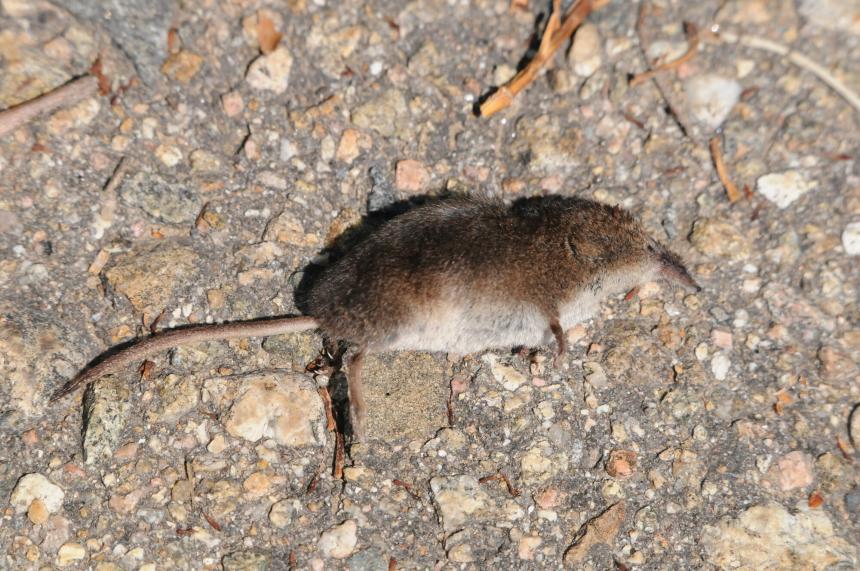Low-
Moderate
This relatively little-known shrew species appears rare but widespread in much of the Columbia Basin and several adjoining localities of eastern Washington. Additional sampling is needed to clarify its status. It may be threatened by habitat loss and fragmentation, and by the invasion of cheatgrass, which is probably detrimental by increasing the occurrence of wildfires.
Description and Range
Physical description
The Merriam's shrew has a total length (including tail) that ranges from 3.5 to 4.2 inches. The tail length ranges from 1.3 to 1.7 inches. Weight of this shrew ranges from 0.14 to 0.25 ounces. The fur is brownish-gray or gray and the underside is white. It is often confused with masked shrews due to the similarity in size. The species are differentiated by skull and tooth morphology.
Ecology and life history
In Washington, Merriam’s shrew is generally found in sagebrush-bunchgrass habitats, especially in areas with big sagebrush, rabbitbrush, and bitterbrush. In other states, they have been captured in mountain mahogany, pinyon-juniper, conifer woodlands, shortgrass prairie, and in wetlands or riparian situations within drier habitats.
Merriam’s shrew is a solitary, nocturnal insectivore that appears adapted to feeding on hard-bodied prey. Diet includes spiders, beetles, caterpillars, crickets, and wasps. Merriam's shrews have been found using vole runways and are known to occupy vole burrows where these species coexist. Shrews are active year-round and forage under the snow in colder regions.
Not much is known about reproduction. It is thought that the breeding season is from mid-March to July, and that females can breed twice a year. In Washington, pregnant females have been captured from April to July, and nursing females in March, July, and October. Litter size ranges from five to seven young. The young are dependent upon their mother until they are 25 days old. Most shrews become sexually mature around 1 year of age.
Geographic range
Merriam’s shrew occurs throughout much of the western United States. In Washington, it inhabits much of the Columbia Basin and its margins. A record in the southern Okanagan region of British Columbia suggests it probably also occurs in Okanogan County, Washington. No estimates of population size or density are available for Washington, but the species appears relatively rare. Due to inadequate and biased sampling, the actual distribution is likely more extensive than documented.
Population trends can only be hypothesized from the reduction in shrubsteppe habitats. Less than 50 percent of the historical shrubsteppe in Washington remains and much of the remainder is fragmented and degraded by wildfires, cheatgrass, and unsustainable grazing in the past.
For a map of state/provincial conservation status and documented distribution of this species, check out NatureServe Explorer.
Climate vulnerability
Sensitivity to climate change
Low-
Moderate
In Washington, Merriam's shrews mainly inhabit shrubsteppe and grasslands. This species may be sensitive to climate-driven changes in prey (e.g., small invertebrates) availability and habitat. Warmer, drier conditions that lead to more frequent and hotter wildfires and/or encourage the growth of invasive plants (e.g., cheatgrass) may degrade or alter natural habitat for Merriam’s shrews in the state.
Exposure to climate change
Moderate
- Increased temperatures
- Changes in precipitation
- Altered fire regimes
- Increased invasive plants
Conservation
Conservation Threats and Actions Needed
- Resource information collection needs
- Threat: Population status and life history have not been well assessed in Washington.
- Action Needed: Current status and life history should be assessed.
- Fish and wildlife habitat loss and degradation
- Threat: Habitat loss and fragmentation have likely impacted the population.
- Action Needed: Use landowner incentives, conservation easements, and acquisitions to protect significant habitats. Initiate efforts to restore and manage habitats.
- Invasive and other problematic species
- Threat: Invasion of shrubsteppe by cheatgrass and other non-native plants has degraded habitats through increased fire occurrence and other processes.
- Action Needed: Restore and manage habitats degraded by invasive species.
See the Climate vulnerability section above for information about the threats posed by climate change to this species.
Resources
References
Johnson, M. L., and C. W. Clanton. 1954. Natural history of Sorex merriami in Washington state. Murrelet 35:1- 4.
Johnson, R. E., and K. M. Cassidy. 1997. Mammals of Washington state: location data and modeled distributions. Washington state GAP analysis, Volume 3. Washington Cooperative Fish and Wildlife Research Unit, Seattle, Washington.
Verts, B. J., and L. N. Carraway. 1998. Land mammals of Oregon. University of California Press, Berkeley, California.
WDFW publications
PHS Program
- Management Recommendations for Washington's Priority Species Volume V: Mammals (see section on Merriam's Shrew)
